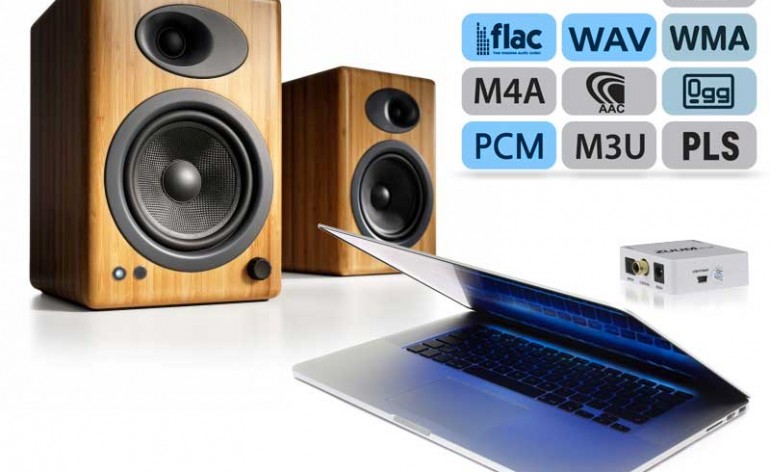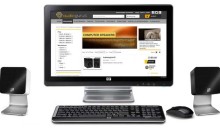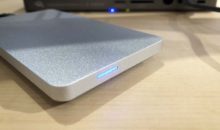HiFi Audio and Your PC – A Definitive Guide
I love high-fidelity or HiFi audio. The trouble is, all of that high-quality audio and all of the time I invest in high-end speakers goes out the door when I sit down to listen at my computer.
But it doesn’t have to.
The thing is, even a great pair of headphones fall flat when they’re receiving audio from what amounts to $0.50 worth of parts in your average PC’s onboard headphone output. So where does that leave you? Wanting more.
And believe me, there’s more to be had.
Treating Your Desk with Some HiFi Audio Dignity
Most people assume that since their computers have sub-par sound, there’s nothing more to be done. That’s not true at all. Let’s start with the audio output. There are three basic components or steps to transforming your computer into a HiFi audio machine:
- Achieve High-Quality Output
- Use Great Quality Speakers
- Remember Your Music Files!
Getting High Quality HiFi Audio Output from Your Computer
The first thing to talk about is bypassing the poor quality audio built into your computer. The way you do this is through the use of an outboard USB DAC (like a Denon PMA-50 USB DAC or something similar). This is essentially an external sound card that connects to your computer via USB. This device is important because it allows all of the audio from your computer to be interpolated and output by this high-end device rather than the cheap onboard audio found in the desktop or laptop computer.
There are multiple options for outboard DACs. Some have a single pair of analogue outputs for a pair of speakers while others include a headphone output or even multiple analogue audio outputs for connecting several speakers (or perhaps a subwoofer). Some even include a digital audio output for use in surround sound systems. A good outboard DAC is the engine behind any solid HiFi computer audio system.
Good Speakers are a Key Component
Now that your output device is fixed, you want to send that pristine speaker level signal to a great pair of powered speakers. You could, of course, send the line-level output of the DAC to an amplifier or even a stereo receiver, but a lot of times a computer-centric audio system is best served by a good pair of powered speakers.
Powered speakers are nice simply because they don’t take up a lot of room and have everything they need right on board. With powered monitors, the amplifiers are built right into the speakers. All you need is the ability to plug them in and feed them a line-level signal from the external USB DAC. There are some very excellent powered monitor speakers out there that sound as good or better than many traditional bookshelf speakers I’ve listened to.
64 kbps Streaming Media Files are NOT Your Friend!
If you set up all of the hardware correctly and purchase great speakers on which to play your newfound audio, it will all be for naught if you don’t also up the quality of your source music. 64 kbps streaming audio files aren’t going to cut it. You need to reach higher and use files of higher quality. We recommend at least AAC lossless or FLAC, however, 320 kbps files are a good alternative if you are using the mp3 format. We recommend lossless files whenever possible because they are…well…lossless. But in blind tests, it is very hard to pick out a high bitrate lossy file format from the lossless. But, if you have the option, go lossless.
So go big or go home…well, go with bigger files anyway. Lossless will take up more storage space but with the constantly dropping prices of storage it’s not such a big deal to hold those files on your computer for a higher-fidelity playback experience.
Conclusion
So when you’re ready, you now know the three components you need to address: The audio device or DAC, the speakers, and the quality of the files you plan on listening to. Miss any one of these and you may improve your Hifi audio system a bit, but you won’t achieve high-fidelity to the level you want if you’re looking to really improve your sound. And really, if you spend a lot of time on your computer as I do, don’t you want that system to at least compete with what you’re used to hearing in your home theater?







Pingback: blog | 64-bit capable
Pingback: My Blog | 64-bit capable
My music experience is completely computer-centric and I currently have 24bit/96hz USB DAC (Native Instruments Audio DJ 2) and a decent pair of active speakers, M-audio BX5A. I am not satisfied with what I get recently and planing to buy stereo amplifier with internal DAC and bookshelf speakers. Will this be a bad move? Should I buy better DAC and better active speakers instead?
An outboard DAC with digital audio output is a misnomer: there’s no digital-to-analog conversion happening in that case. And if you’re hooking your computer up to a surround-sound system, don’t use an S/PDIF digital audio connection, as that can only handle two channels of uncompressed PCM audio. Use an HDMI (or DisplayPort) connection instead.
Is the CL Soundblaster ZXR internal sound card a ‘DAC’? I am completely ignorant of audio.
Yes. Digital Audio Converter. Anything that takes digital audio and allows it to output as analogue (somewhere) is a DAC.
Hy!
Please help with the answer.
Many of us, due to costly investments, have multichannel receivers and PCs, connecting the pc with recever can be done, analog and exclude it, we want a digital connection, the recever maker boasts a good internal dac.
My questions are:
-There is a difference between the hdmi and the optic connection, which one is more useful and direct to the receiver Dac?
-Is the sound card of the PC important for hdmi stereo pcm or dolby encoding?
I want to send audio on my pc to remote speakers. What do I need?
Right now I have a high end DENON connected to my motherboard via a Toslink (as my DENON is older and does not have HDMI). I then assigned the Toslinkl to “DVD” on the DENON(both in on rear panel and inside the settings on the DENON) and my motherboard recognizes it as digital, so I selected it and BAM! Surround 5.1 via my comp out to my DENON running 2x Infinity Towers, 2x Infinity bookshelves, 1x Infinity center, 1x Velodyne 1000w 12″ sub.
“…in blind tests, it is very hard to pick out a high bitrate lossy file format from the lossless.”
Um… yeah. You can’t tell the difference, because there isn’t one. All compressed formats sound awful. WAV is the only format that doesn’t lose quality and it’s impossible to find unless you rip your own CDs. If you’re going to listen to compressed audio, stick with your ear buds and buy more music instead.